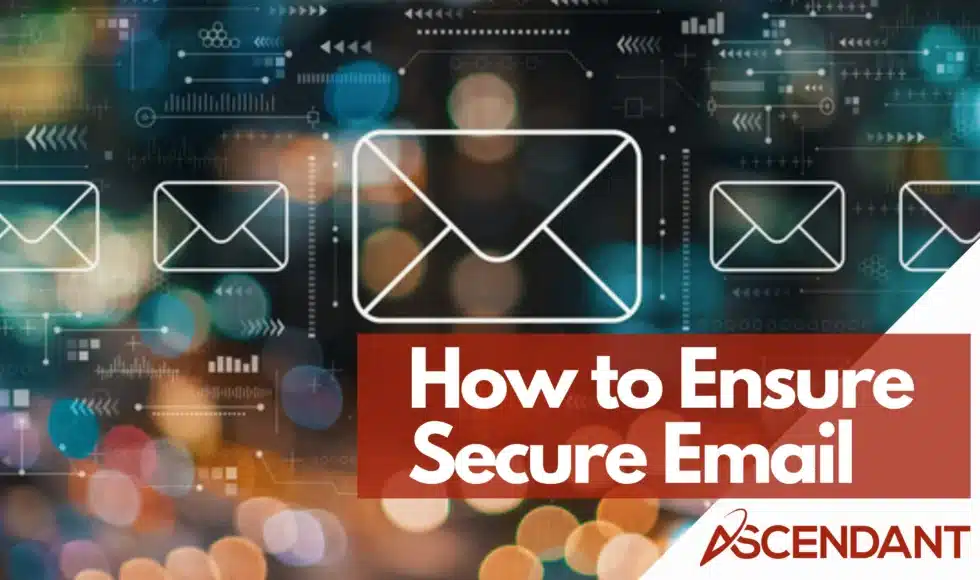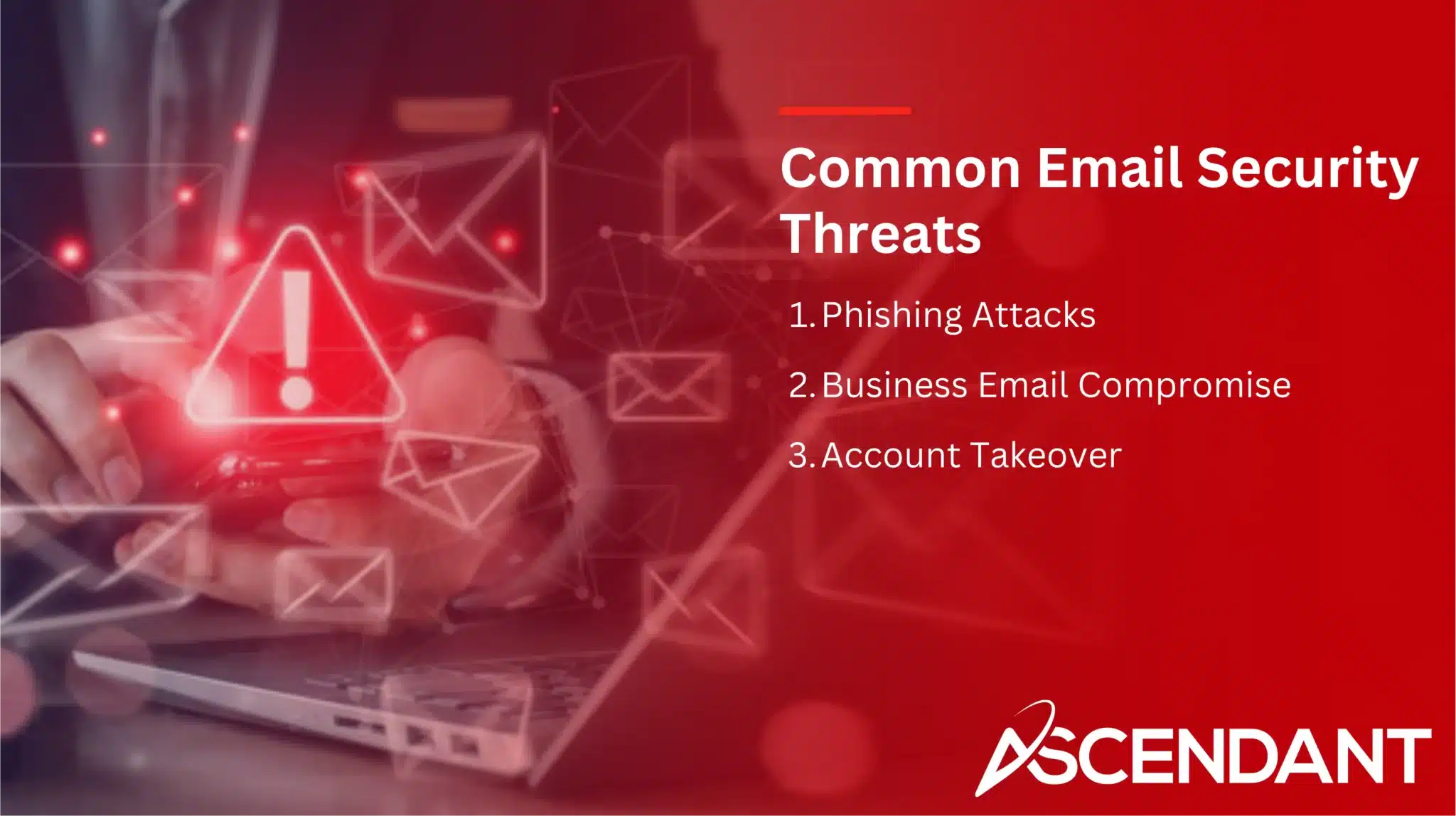In today’s digital age, having secure email is essential to guard against cyber threats. This guide will show you how to protect your email through encryption and other key strategies. Learn best practices, common threats, and the top providers of secure email services.
Key Takeaways
- Secure email practices, particularly encryption methods like S/MIME and PGP, are essential for protecting sensitive information from unauthorized access and ensuring privacy in communications.
- Organizations must remain vigilant against a variety of email threats including phishing, business email compromise, and account takeovers, which can lead to significant financial losses and data breaches.
- Implementing measures such as multi-factor authentication, regular training programs for employees, and utilizing secure email gateways greatly enhance email security and reduce the risk of successful cyberattacks.
Understanding Secure Email
The concept of secure email encompasses a variety of techniques designed to shield electronic mail from being accessed by unauthorized entities. In the face of ever-evolving and sophisticated cyber threats, it is essential to ensure that both messages and sensitive data are kept confidential in order to preserve their privacy and authenticity. Email encryption is a critical component within this framework. It transforms the content of emails into a code unreadable by unintended parties. With end-to-end encryption, confidentiality is assured since only the intended sender and recipient have the capacity to decrypt and read what’s sent—thereby guaranteeing that no modifications occur during transmission, which strengthens trustworthiness between businesses as well as with their customers or business allies.
Email encryption can be implemented through various methodologies. S/MIME hinges on digital certificates issued by centralized authorities for confirming senders’ identities, whereas PGP operates under decentralized key management allowing individuals control over generating and handling their own keys—a means more conducive for user-managed security processes. While Transport Layer Security (TLS) secures communication channels between mail servers against interception or eavesdropping, it stops short of encrypting actual message contents.
In parallel with these measures, utilizing Virtual Private Networks (VPNs) solidifies email safety due to its ability to scramble internet connections themselves. By adopting robust strategies like email encryption mechanisms alongside VPN usage allows institutions not merely an enhancement but also comprehensive fortification when dealing with personal information—and crucially—to buffer against persistent online risks concerning sensitive information protection.
Common Email Security Threats
The purpose of email security is to shield against various risks such as data theft, impersonation, malware invasion, phishing attempts, and unwanted spam. Companies often face dangers like account takeovers and business email compromise (BEC). The significant issue of spear phishing adds to these concerns. Given that 94% of cyberattacks commence with a deceptive email message, it’s clear that emails pose a substantial risk for being an entry point for attackers. These types of attacks can lead to considerable financial harm which might reach into billions in losses.
Emails are commonly used vectors for disseminating malware—either through attachments or via documents laden with malicious code. Spammers exploit unsolicited emails not only to distribute malware, but also to steal sensitive information from unsuspecting recipients. The introduction of malware onto computers can result in unauthorized extraction or encryption of files. This could trigger extensive data breaches and forfeiture of essential proprietary data. Constant caution is crucial. Individuals should avoid engaging with dubious links or downloading files provided by unfamiliar sources.
Social engineering schemes leverage people’s inherent inclination toward trustworthiness as a means towards gaining illegitimate access or acquiring confidential information unlawfully. It is imperative that organizations train their staff on how to recognize treacherous communications while implementing stringent security measures within their protocols rigorously. Cybersecurity teams need continuous vigilance over fluctuating threats presented by electronic correspondence and must persistently modernize defense strategies in anticipation of novel challenges.
Phishing Attacks
Phishing is responsible for the majority of email security threats, with attackers impersonating legitimate entities to deceive users. These attacks constitute 96% of email threats, underscoring their prevalence. The main goal of phishing attacks is to trick victims into divulging private information, such as passwords or financial details. Consequences of successful phishing attacks can be severe, including identity theft and substantial financial losses. Phishing pages and emails often look polished and plausible, making them difficult to identify.
Spear phishing refers to more targeted phishing attacks designed to deceive a specific person or group. Attackers use malicious links in emails to direct recipients to webpages they control. These sophisticated attack methods exploit trust and urgency to deceive victims.
Regular training should include recognizing phishing attempts and understanding proper email handling practices. Organizations should conduct regular training sessions on identifying phishing attempts and suspicious attachments.
Business Email Compromise
Business Email Compromise (BEC) is a sophisticated form of spear phishing that dupes individuals into revealing sensitive data or making financial transfers. From 2013 to 2022, the FBI’s Internet Crime Complaint Center has documented significant monetary damages resulting from BEC, with an estimated total loss of around $50 billion.
These attacks are highly treacherous due to cyber criminals skillfully masquerading as reliable entities or contacts. The severe economic repercussions combined with these cunning techniques position BEC among the most serious threats facing companies today.
Account Takeover
An account takeover happens when a cybercriminal obtains access to a user’s online account. This can include their email as well. Common methods for attackers to take over email accounts include credential theft through phishing attacks or malware. Once attackers gain control of a user’s email account, they can use it for spear phishing, send spam, access other accounts via password resets, launch further attacks, or impersonate the account owner.
Preventing account takeovers involves robust cybersecurity measures, such as multi-factor authentication and regular email account monitoring.
Benefits of Using Encrypted Email Services
Email encryption services play a pivotal role in safeguarding sensitive data against cyber threats. By transforming the contents of emails into an indecipherable format, these services ensure that only authorized recipients can decode and read the communication. This critical layer of protection preserves the confidentiality of sensitive information while bolstering trustworthiness in business interactions.
Innovative features are provided by various encrypted email services to strengthen secure communications. Preveil integrates with existing email accounts offering robust encryption, while Virtru automates key management for simplifying encryption without user intervention. SecureMyEmail delivers a complimentary service tier compatible with current email accounts which assists in adhering to compliance mandates. These platforms empower companies and individuals alike to protect their correspondence from unauthorized disclosure, ensuring privacy preservation.
Utilizing encrypted email not only serves as a defense for protecting confidential data, but also aligns with regulations concerning data security practices and fortifies network defenses against infiltration attempts. Crucial for abiding by legal standards set forth by statutes like HIPAA and GDPR, encrypted messaging tools provide essential means for circumventing unsanctioned access and potential incidents involving loss or theft of data, thereby mitigating exposure to digital dangers significantly.
Protect Sensitive Data
Email encryption is essential for maintaining privacy and securing unauthorized access, transforming sensitive data from an easily readable plain text format into a coded form. This ensures that only the sender and recipient have the ability to decipher the contents of an email, which is crucial when dealing with high-stakes confidential information like Social Security numbers or protected health details. It’s critical to implement robust measures to protect sensitive information such as financial records and personal identifiers during external email communication.
Utilizing Tuta. Mail’s open-source platform allows individuals to send an unlimited number of encrypted messages, elevating their overall security posture. With Tuta Mail’s solution, every aspect of an email—including subject lines and contacts—is securely encrypted, offering users all-encompassing protection.
By adopting strong encryption practices, one can significantly minimize the chances that malicious entities will gain access to sensitive data. The adoption of rigorous systems along with well-defined policies plays a vital role in preventing users from inadvertently sending out sensitive information via emails externally—thus bolstering email security comprehensively.
Ensure Compliance
Organizations are assisted in adhering to data protection regulations through the use of encrypted email services. Encryption is a strongly recommended measure for safeguarding sensitive data under various regulatory guidelines such as GDPR and HIPAA. By employing encrypted email, organizations can fulfill their compliance obligations, avoid potential fines, and preserve their clients’ confidence.
Enhance Network Security
Users are required to secure a security certificate to activate complete encryption and digital signatures, crucial for secure communication. Encrypting email messages bolsters network security by shielding sensitive information from unauthorized interception, ensuring data remains confidential and intact during its transmission.
By using digital signatures within email communications, the authenticity of the messages is validated. This allows recipients to ascertain that the emails they receive are legitimate.
Top Secure Email Providers
The importance of email security cannot be overstated when it comes to safeguarding encrypted communications and sensitive data. Service providers specializing in this area deliver advanced security functionalities, making sure emails can only be read by their intended recipients. Leading the pack are secure email services such as Proton Mail and Tuta Mail, which provide comprehensive end-to-end encryption alongside interfaces designed for ease of use. Providers like Preveil and Virtru also concentrate on delivering strong encryption capabilities to their customer base.
Renowned for its stringent privacy measures is Proton Mail, a service that not only incorporates end-to-end encryption but also maintains a zero-access structure to guarantee user-exclusive control over personal information. It goes on. In enhancing anonymity by disabling image tracking within emails – features that solidify its reputation as one of the premier encrypted email platforms dedicated to preventing unauthorized access and surveillance.
To these security traits, Tuta Mail implements robust protections through encrypted storage systems while maintaining an accessible interface for users’ convenience. To ensure all-around defense, Tuta Mail extends encryption protocols across message headers and contact lists alike. For interactions with contacts outside the Tuta network, password establishment between parties is carried out separately before communication ensues – bolstered even more via disposable email addresses provided by Tuta’s DEA feature.
Beyond these names are other contenders like Preveil and Virtru who put forth assorted options concerning encrypting methodologies geared towards fortifying confidential exchanges against breaches or unsolicited scrutiny from third parties.
Proton Mail
An esteemed provider of encrypted email services, Proton Mail, places a high emphasis on protecting its users’ privacy through advanced security measures. A notable function of the service is its capability to send password-protected emails to individuals who do not use Proton Mail. It boasts an option that prevents image tracking within emails, thereby boosting both privacy and safety for its users. The combination of these aspects establishes Proton Mail as a premier selection for those vigilant against unauthorized data access and surveillance.
Fortifying user protection is Proton Mail’s zero-access construction, which guarantees that only account holders can view their own information. By integrating thorough encryption with robust privacy mechanisms, this email service reinforces its status as a dependable platform for secure communication.
Tuta Mail
Renowned for its robust security features, Tuta Mail provides encrypted storage and boasts an intuitive interface. It secures all user data from message headers to contact details with encryption, providing thorough safeguarding measures. When interacting with contacts who do not use Tuta Mail, a password must be set up by the user and communicated through an alternative method.
Tuta Mail informs recipients outside its network of incoming messages by sending them a notification containing a link to access their correspondence securely. To these features, Tuta Mail enhances email privacy by offering users the option of creating disposable email addresses (DEAs), which serve as one-time aliases for heightened email security.
Other Notable Providers
Preveil, Virtru, and SecureMyEmail are additional secure email providers that provide different encryption services to safeguard sensitive information. Preveil enables users to encrypt their communications while retaining their current email addresses. On the other hand, Virtru simplifies the process by dealing with encryption keys automatically without needing the user’s input.
For recipients to access encrypted messages sent via Preveil’s service, they must install Preveil on their devices.
Implementing Multi-Factor Authentication
Multi-factor authentication (MFA) enhances email security by requiring two or more verification factors for account access. MFA primarily reduces the risk of unauthorized access to email accounts. For maximum MFA security, use a combination of a password, a smartphone app, or biometric data. Two-factor authentication adds an extra layer of protection to email accounts.
Email services that support multi-factor authentication include Proton Mail, Private-Mail, StartMail, and Tuta Mail. By integrating MFA with existing systems, organizations can enhance security while maintaining user ease.
MFA can mitigate the risks associated with credential compromise from phishing, as attackers will still require additional methods.
Advanced Threat Protection Solutions
Implementing encryption for email communications is vital to shield sensitive data from unauthorized interception, thereby boosting privacy. It’s imperative that businesses continuously update their security measures in order to fend off novel and evolving threats posed via email. The automatic updating of these security protocols is critical in safeguarding against the advancement of vulnerabilities. Staying current with updates to email security ensures robust defenses against newly arising cyber threats.
In addressing complex email threats, advanced threat protection systems play a crucial role. These systems often encompass elements like secure email gateways, digital signatures, and the implementation of the Sender Policy Framework (SPF). When such strategies are put into place by organizations, they significantly strengthen their stance on securing emails from various types of cyber attacks.
Secure Email Gateway
Secure email gateways are essential for safeguarding users from malicious emails by filtering out dangerous content before it lands in their inboxes. These gateways use a variety of detection engines, alongside advanced threat intelligence, to halt threats and block harmful emails, thereby preventing account takeovers and various forms of malign activities.
Proactive defense is key to ensuring the security of email communications.
Digital Signatures
Employing cryptographic methods, digital signatures ascertain the legitimacy and integrity of email messages to verify their authenticity. This process guarantees that the contents of emails are not modified while they are transmitted.
By validating the identity of the sender, digital signatures provide an additional security measure to protect sensitive data within email communications.
Sender Policy Framework
The Sender Policy Framework (SPF) combats spam by validating the sender’s IP address, safeguarding against email spoofing and phishing attempts. It ensures that only authorized mail servers are allowed to send emails for a domain.
Through DNS records, SPF designates permissible mail servers for a domain so that recipient servers can authenticate the legitimacy of incoming messages. This mechanism is critical in blocking malicious emails from infiltrating user inboxes.
Best Practices for Email Security
Ensuring strong email security requires adherence to established best practices. Key among these is the employment of multi-factor authentication (MFA), which significantly diminishes the chances of unauthorized access through its requirement for various forms of verification.
Employing secure email gateways is essential. They deploy filtering methods that prevent malicious content from entering a user’s inbox. Regularly updating your software and systems plays a critical role in guarding against potential weaknesses and maintaining robustness within your email security solutions.
Use a Password Manager
A password manager assists users in generating and overseeing robust, distinct passwords for a multitude of accounts, streamlining the process of maintaining strong, unique passwords across different platforms.
By producing intricate passwords that are less susceptible to being guessed with ease, password managers diminish the likelihood of security breaches and thus improve overall protection.
Train Employees
Training in email security equips employees with the necessary skills to recognize and respond correctly to cyber threats. It is crucial that training programs include instruction on spotting email spoofing, recognizing phishing attempts, adhering to password best practices, and managing dubious emails.
To ensure staff members are up-to-date on the most recent threats related to email security, it’s vital that educational materials be refreshed regularly. This proactive approach ensures they are well-equipped to confront new and changing cyber threats effectively.
Regularly Update Security Features
It is crucial to consistently refresh the security features of email systems to guard against the continuously changing landscape of cyber threats. By implementing definitive protocols, organizations can avoid accidental dissemination of sensitive information by users. Maintaining current security practices enables entities to prevent potential weak spots and maintain a strong network security posture.
 Summary
Summary
To conclude, fortifying email communication necessitates a comprehensive grasp of potential cyber threats and the application of stringent security protocols while keeping abreast with cutting-edge best practices. A plethora of strategies exist to safeguard sensitive data, encompassing the use of encrypted email services, multi-factor authentication, secure email gateways for advanced threat protection, and digital signatures. Adhering to these recommended measures can substantially bolster an organization’s defense against the constantly shifting spectrum of cyber dangers that threaten email security.
Frequently Asked Questions
What is the main purpose of email encryption?
The main purpose of email encryption is to protect the confidentiality of email content by converting it into an unreadable format, ensuring that only the intended sender and recipient can access the information.
How does multi-factor authentication enhance email security?
Multi-factor authentication significantly enhances email security by requiring two or more verification factors, which minimizes the risk of unauthorized access to accounts.
This added layer of security helps protect sensitive information effectively.
What is a secure email gateway?
A secure email gateway is essential for safeguarding your communications, as it effectively filters out malicious content and protects against email-based threats before they reach users’ inboxes.
This ensures a more secure email experience.
Why is it important to use a password manager?
Using a password manager is essential as it generates and stores strong, unique passwords for each account, significantly reducing the risk of password reuse and enhancing your overall security.
This protects your sensitive information from potential cyber threats.
How do digital signatures contribute to email security?
Email security is substantially improved with the use of digital signatures, as they confirm the sender’s authenticity and safeguard message integrity by thwarting any alterations during transmission.
The importance of this technology lies in its ability to preserve confidence within digital communications.


